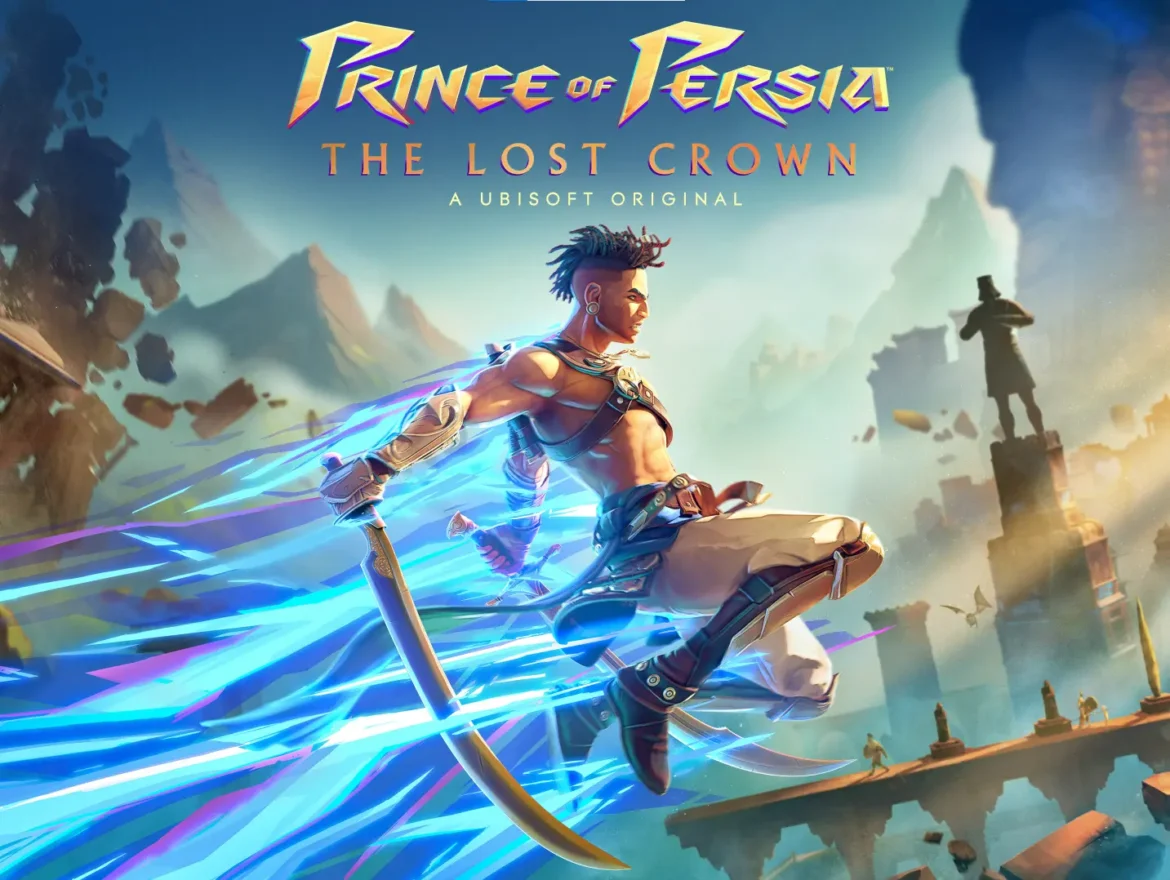Release Date : 18 January, 2024
Developer(s) : Ubisoft Montpellier
Publisher(s) : Ubisoft
Platforms : PS4, PS5, Xbox One, Xbox Series X/S, PC, Nintendo Switch
Many years ago, Jordan Mechner created Prince of Persia, a game that was considered a pioneer in the action-platformer genre. Featuring revolutionary mechanics and technology at the time, it made a huge impression in the late 80s. Almost 35 years after its birth and 14 years after its last episode, the hero of Persia is back in better shape than ever, thanks to Ubisoft Montpellier, in a Metroidvania blazing like the sand of the Iranian desert.
Table of Contents
One Thousand and One Nights on Mount Qaf

From a place of wonder, Mount Qaf is now under the influence of a terrible curse. When Sargon travels into the sweltering depths of this unusual place in search of the kidnapped prince, he witnesses some horrifying events that appear to come from the scary fairytales we tell our children to make them fear outside threats.
The dead rise, monsters emerge from their lairs, corridors become labyrinths and time goes haywire. The youngest representative of the Immortals faces dangers matching those of the mystical guardians described in the legends. Death lurks everywhere and takes many forms, from the most recognizable with ravenous monsters or protruding spikes, to the most concealed.
The story of Prince of Persia: The Lost Crown is portrayed through animated artwork and cutscenes using the game’s engine. While the developers mention storytelling as one of the four pillars of the experience (alongside exploration, platforming, and combat), it is clearly not a core element.
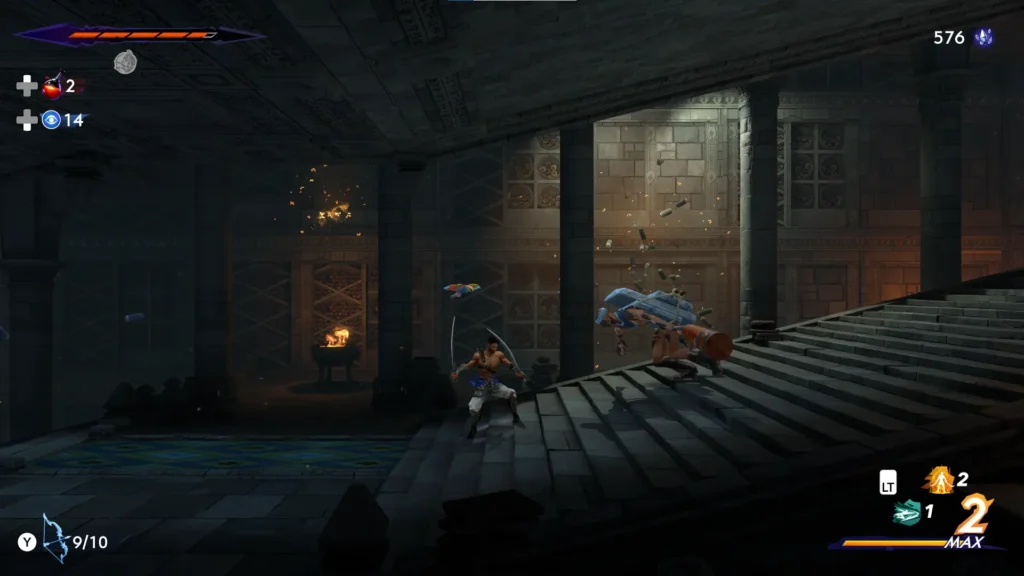
The scenario is a pretext for getting us from one zone to another as naturally as possible. Not quite impressive despite a few twists and turns, it presents heroes who aren’t necessarily engaging, starting with Sargon himself. Nor do the few friendly NPCs who wander through the maze stand out from the crowd.
Although the writing quality has never been the most important element in a Metroidvania, it does help the player to empathize with the protagonists and feel the joy, fear, or sadness of key events. Despite its efforts to engage us with the story, The Lost Crown’s plot remains fairly conventional.
However, the studio manages to introduce a series of gigantic bosses, to change our habits thanks to gameplay variations, and to present new creatures with great efficiency. We would have liked to see some impressive pursuits, but perhaps we’re asking a little too much.
Overall, the game suffers from a distinct lack of originality. True, Metroidvania is a genre that has seen many champions in recent years, but we would have liked to see a more distinctive identity. The same goes for the settings: palaces, cellars, moats, forests, mountains, deserts… all the classic Metroidvania boxes are plugged in.
Back to Basics
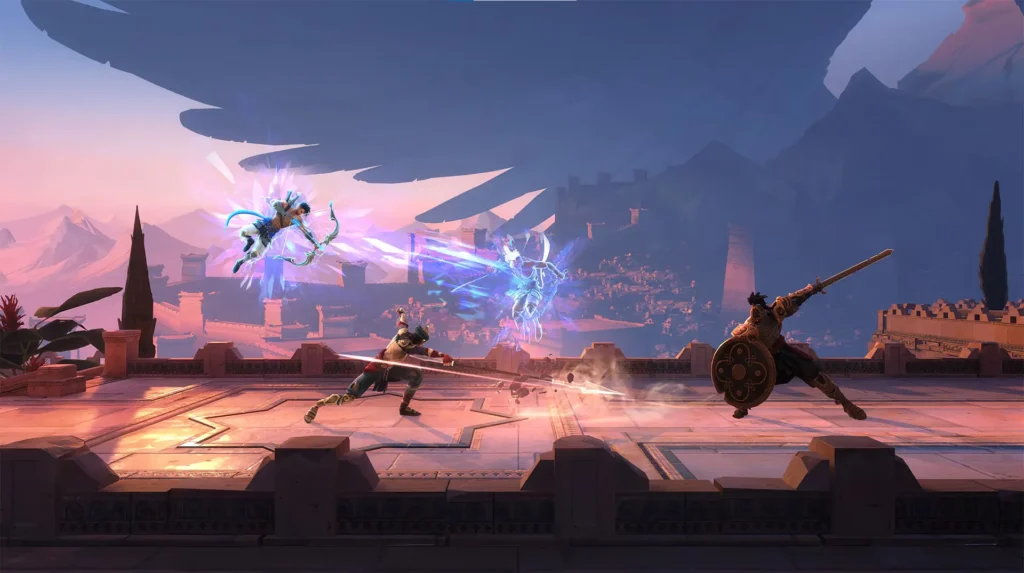
As we all know, the most important thing in an “Action-Adventure-Platformer” is not its story, but its gameplay! Prince of Persia: The Lost Crown abandons the full 3D action-adventure of 2003-2010 in favor of 2.5D Metroidvania. Initially, this choice sounds like a return to our roots, as we follow the hero’s actions with a profile-view camera, just as when Jordan Mechner introduced us to the charms of the series on the Apple II.
Except that with this new episode, the French studio borrows more from Ori and the Will of the Wisps, The Last Case of Benedict Fox, Hollow Knight, and Metroid Dread than it does from the old games. The whole vocabulary of the genre is used, with doors to open, secret passages to flush out and seals to break. The recipe is right.
Old builders know: a castle’s foundations must be solid in order to stand the test of time. And time clearly needs to be spent if the players want to explore the arteries of this universe from top to bottom. As a Metroidvania, Prince of Persia: The Lost Crown is divided into different zones (palace, forest, catacombs, port village, etc.) within the same world (Mount Qaf). Paths are unlocked gradually as the player acquires new skills.
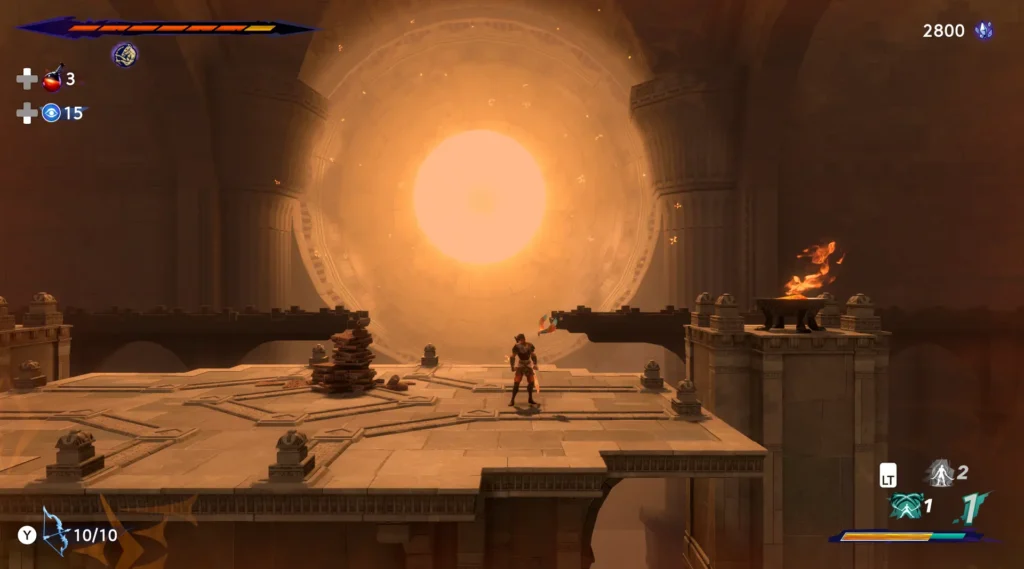
Maps for these zones can be purchased by spending a little money with an NPC, which is clearly not a luxury when it comes to finding your way around this mass of corridors and caverns. As usual, you’ll need to keep your eyes peeled, as the solution to a problem always lurks unnoticed in the background, especially in some of the more twisted puzzles.
While it may be easy to get lost in the game’s plethora of galleries, Ubisoft has thought of everything to make exploration a pleasure. Starting with the golden breeze that indicates the path to follow to activate a Wak-Wak tree (which serves as a checkpoint, for recharging healing potions and customizing amulets).
The developers have also integrated a “photography” system directly into the game, enabling screenshots to be pinned to the map. The Lost Crown also features two exploration modes: one designed for fans of the genre, and another for those who want to save time, with more precise icons marked on the map. It’s a pity that the trees aren’t used for fast travel, offering a function dedicated to finding steles that aren’t always ideally placed.
Finally, not every Metroidvania thinks of this: the left stick moves the camera to reveal what’s hidden a few meters ahead, behind, above, or below, which is very practical. To ensure good visibility, the hero appears superimposed on the elements of the scenery in the foreground. Nice touch, Ubisoft!
Legend of the Piercing Hero

In addition to wandering sprawling labyrinths and solving puzzles, the player’s main task is combat. Movements – useful in both exploration and action phases – are varied: running, jumping, dashing, wall-to-wall leaps, sliding… everything is available to get out of the most dangerous situations. Whether he’s using his blades, magic, bow, or chakram, Sargon has what it takes to make his opponents bite the dust in a violent storm.
Unlike other Metroidvania games on the market, this Prince of Persia encourages swift confrontations. The wide range of moves, combined with gameplay that highlights precise timing for parrying/countering, brings it closer to what we see in popular fighting games. A single opponent of advanced level is capable of posing major problems if you just smashing the attack button. Unlike The Last Case of Benedict Fox, crystals are granted each time an enemy reappears. It’s therefore possible to grind and buy yourself some nice upgrades in the store.
With a little practice, you’ll learn to glide to avoid lethal blows, send opponents flying to make them vulnerable, throw guard to punish the opponent, and activate special moves when Athra’s gauge is full. This gauge is charged when Sargon deals damage and goes down when he receives it, forcing the player to take risks in order to have the opportunity to unleash a saving magic (attack or healing).
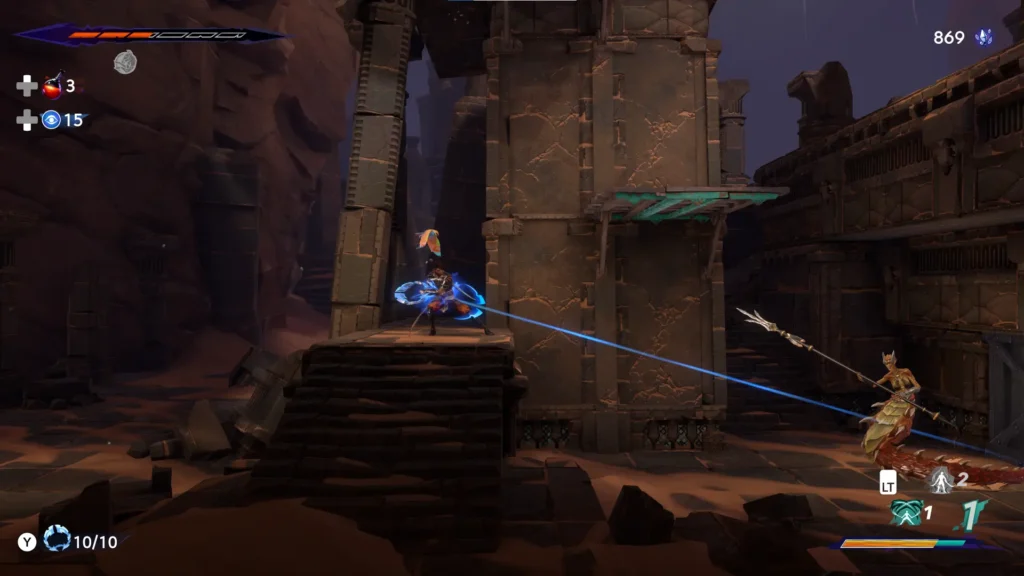
However, even if we’re borrowing the codes of versus fighting, we’d have liked to be able to execute the mugs, especially when the warriors are able to get out of them. Among the few inaccuracies we came across was the mapping of the super attack to LT+X, which was mistakenly triggered in a hurry, LT being used to parry and X to attack.
Thanks to a system of amulets to find and equip, Prince of Persia adapts to the player’s desires. By combining skills that meet your expectations, Sargon will set fire (literally) to enemy ranks. Unless there are too many of them, in which case he will take a beating, especially on the more advanced difficulty levels.
While the combat gameplay is well-designed for 1v1 or against small groups of enemies, it quickly shows its limits when hordes of opponents stand in your way. When the bad guys outnumber the hairs on Sargon’s head, which happens several times during the adventure, we enter a mess that’s more brawling than technical, where running for your life is more important than anything else.
Two times, three moves
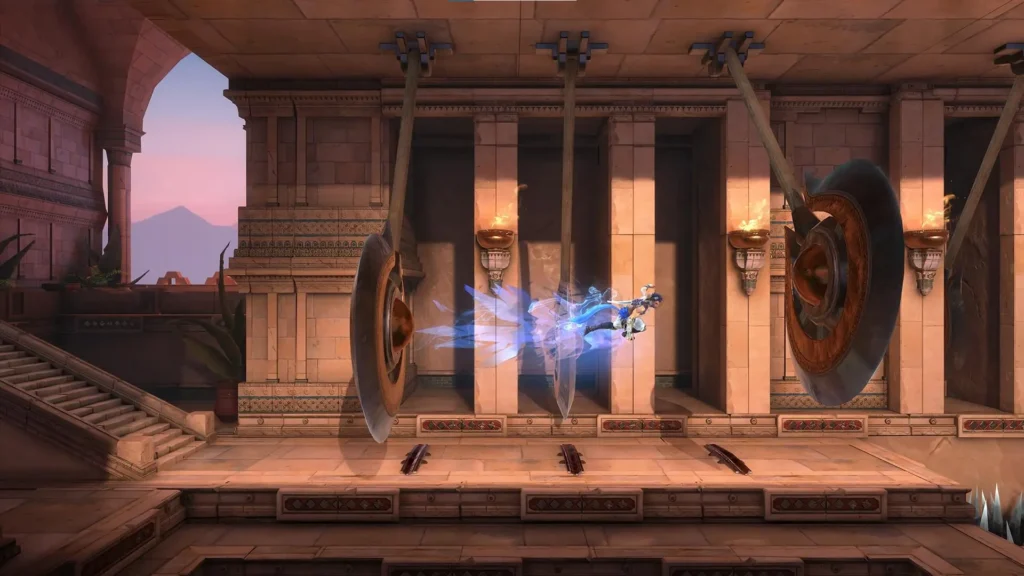
There was a time when Prince of Persia focused most of its mechanics on time. This is not the case for this 2024 episode. Although time is still important in certain scenes, it is no longer central to the experience. In fact, apart from scripted sequences where everything is frozen on screen, and those against the main antagonist who has mastered rewind, time is no longer really part of the Prince of Persia experience.
Players can indeed create an imprint of their avatar in the world and teleport to it whenever they like (useful both in combat and for solving puzzles), and they can trap opponents in a parallel world in order to throw them out later, but beyond these few examples, The Lost Crown avoids anything to do with time and space in its gameplay. It’s a shame.
The range of actions, which is broad when you add the abilities acquired during the journey, allows the level designers to show off the extent of their talents. The levels make clever use of the hero’s skills. Some areas feature hardcore platforming that leaves no room for error. Tense platforming and vicious traps, Ubisoft’s upcoming title has plenty of them, yes! Fans of “try hard” will get their money’s worth.
Unfortunately, approximations are also part of the game, and small mistakes become annoying towards the end of the adventure when error is no longer allowed. This is when you notice hitboxes that aren’t always brilliant, sneaky slow-motion, collision bugs with moving platforms, and shock animations that can lead to an endless loop of damage. All of which makes a tough challenge (especially when faced with bosses) seem slightly unfair (on rare occasions).
Eye-Popping Dragon
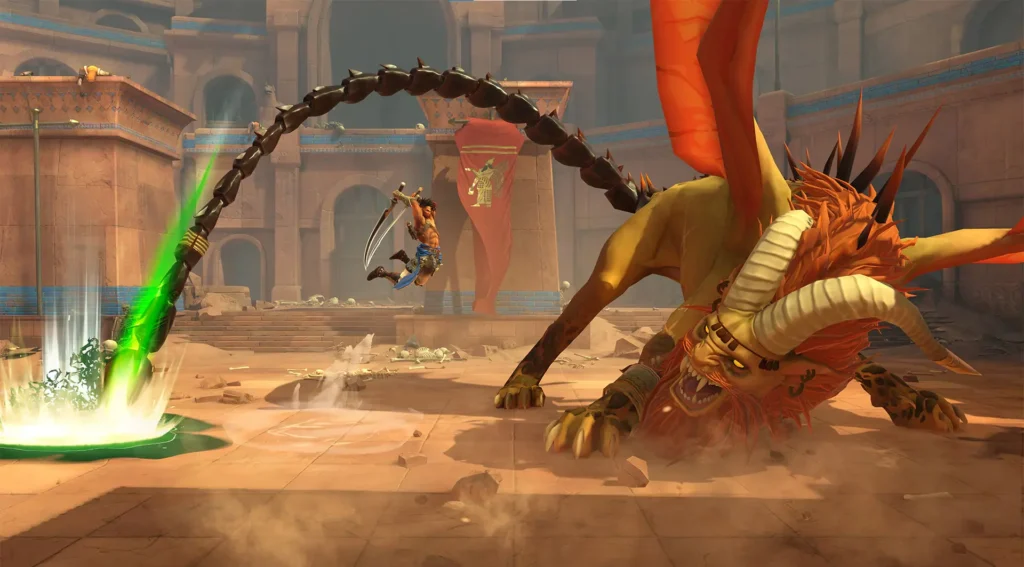
Running at 60fps even on a Switch, with the possibility of going up to 4K/120fps on PS5 and Xbox Series X, Ubisoft’s title is delightful to the eye. 3D modeling is well done, textures are plentiful, and combat-related special effects look great. As you’ll have noticed from the screenshots, the game’s style is inspired by Japanese anime and comic books. Both the super attacks and the design of some of the big bad guys are furiously reminiscent of Dragon Ball Z, a source of inspiration clearly mentioned by the artists at Ubisoft Montpellier.
The software mixes 2D landscape artworks with 3D objects, locations, and characters. Older fans of the game will surely regret the fact that the artistic direction is a long way from the original game, with too discreet oriental accents that are supposed to meet the expectations of a fairly young audience. But Ubisoft has opted for modernity.
While it may not be revolutionary from a purely technical point of view, The Lost Crown manages to leave a good impression thanks to its outstanding fluidity. Very successful for the Switch, it must be said that the game isn’t very impressive on PS5 and Xbox Series X, due to textures that aren’t always very detailed, missing special effects, and, above all, animations that aren’t always top-notch when it comes to opponents and NPCs. Cinematics with animated artworks, or dialogues with images of the characters, remind us that Prince of Persia certainly didn’t benefit from a budget worthy of the publisher’s latest AAA releases.
To further immerse us in this revised Persia, the sound ambiance has been given special attention. The background music, although a little repetitive depending on the time spent in a zone, is of good quality. The more epic themes, composed by Gareth Coker, are excellent. The sound design, for its part, combines finesse and quality for a virtually flawless result.
Conclusion
Prince of Persia: The Lost Crown is fluid, well-paced, and easy to handle, with multiple settings to suit all gameplay styles. Relying on the best references of the genre at the risk of not allowing its personal touch to shine through, the game ticks all the boxes of a great action adventure platformer. Ubisoft has produced a Metroidvania that meets all the specifications, smoothly and without any major flaws, but also without that little something that makes it unique like a precious gem. If you like the genre, go for it!
